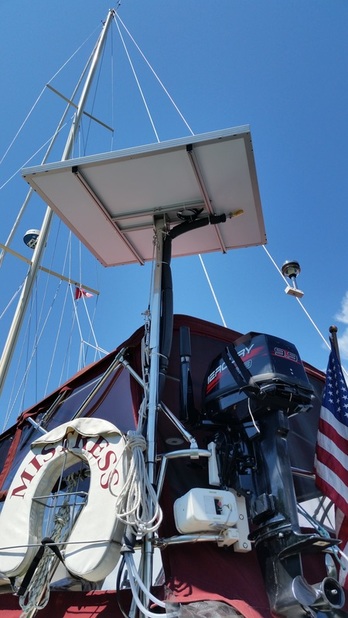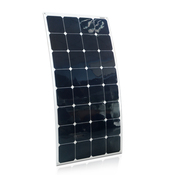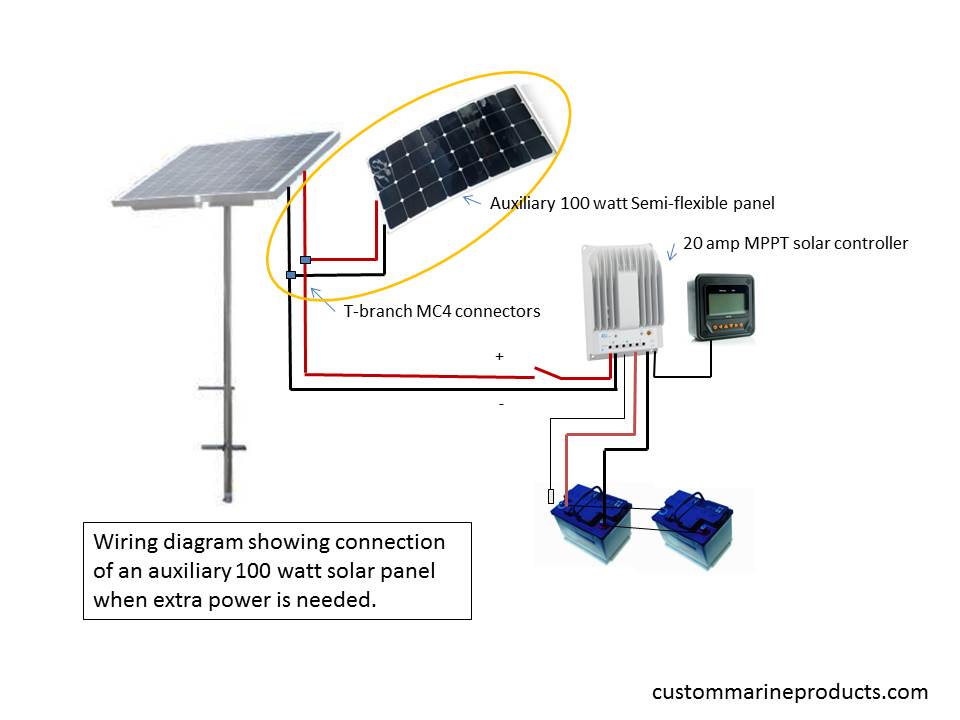 120 Watt Solar Panel on a Pole Mounting System with Water Heater and Crane Options 120 Watt Solar Panel on a Pole Mounting System with Water Heater and Crane Options This year we tested our new 120 Watt SunPower cell solar panel with our integrated water heating system on a 5 week cruise in Northern Lake Huron at a latitude of about 46 degrees. We used an EP 20 amp MPPT Controller. A 10 amp controller would have been sufficient but we wanted extra capacity so we could plug in an auxiliary 100 watt semi-flexible panel as a backup if we needed additional power because of a series of cloudy days. Plugging in an extra panel is simple using the MC4 connectors and an MC4 T-branch connector. We had mostly sunny days so we didn't need additional power beyond what the 120 watt panel provided. The weather was awesome! The 120 watt panel was mounted using our CMP pole mounting system so I could tilt and rotate the panel to achieve optimum sun angle. I set the sun angle once and rotated the panel three times a day (morning, midday, evening) and figure I got about 30% more performance over a fixed horizontally mounted panel. Operating statistics: Our power usage averaged approximately 70 amp hours or 850 watt hours in a 24 hour period. Our current draw was from a refrigerator/freezer running 24/7, our LED lights in the evening, cell phone chargers, laptop computer several hours a day and our radios and instruments during the day. Our windlass is only run when the engine is running so we don't include it in our power consumption calculation as the alternator quickly makes up for its power usage. We have a 75 amp Balmar alternator with a smart regulator. Our house bank consists of 3 flooded cell batteries giving us a total capacity of 330 amp hours. We started the engine to move anchorages about every three days. Results and findings: 1. Our battery bank was fully charged by 2 PM most sunny or mostly sunny days when at anchor. This is in contrast to 12-1 PM in past years using our 150 or 160 watt panels on poles. 2. The EP Tracer BN MPPT controller with the remote display proved to be an outstanding piece of equipment. It was simple to program, easy to read, collected the appropriate data and was very efficient. It was exciting (I get excited about these things) to see 8+ amps being poured into the battery bank in the morning. It would be frustrating to see it only outputting and amp or two in the afternoon in full sun but then you realize it is doing its job. It fully charged the batteries in the morning and was in float mode topping off the battery bank in the afternoon. 3. Rotating the panel during the day, especially in the morning, significantly increased the power generation of the panel. 4. Our weather was so sunny and the panel performed so well we had no reason to plug in the auxiliary 100 watt flexible panel using an MC4 T-branch for extra charging power. I plugged it in one morning just to confirm the configuration would work and was easy to do. It worked well and brought the charging amps to well over 12 amps. 5. The data gathered confirmed that this panel configuration supplied all the power we needed and has excess capacity to catch up on battery charge from a string of cloudy days. 6. The panel was affected by shading as would be expected. Occasionally the panel was shaded by the back stay or the mast. While the shading was minimal, it degraded the performance by up to 40%. Data: At anchor Motor Sunny to Cloudy to Mostly Sunny Mostly Cloudy Average watt hrs per day 740 540 650 290 Average amp hours per day 57 45 50 22 Maximum watt output in 24 hours 960 630 960 540 Minimum watt output in 24 hours 200 200 420 170 Observations: 1. The minimum watt hour output doesn't mean much because it is dependent on both the cloud cover and the state of charge of the bank as a result of alternator charging, 2. The maximum watt hours per day of 960 is not the maximum output capacity of the system in a 24 hour period because the batteries were charged by 2 PM so the controller shut down the charge from the panel. A higher drain on the house battery bank would have resulted in this number being higher. 3. Average amp hours per day is computed by dividing the watt hours by 13 volts. This is a ballpark calculation. 4. This configuration proved to have plenty of capacity for our cruising needs even without using the auxiliary solar panel. We have not used shore power to charge our battery bank for the entire summer. Solar Water Heater: We installed our new solar water heating system. It consists of a heat collector or heat exchanger mounted on the back of the solar panel, and a circulating pump. See our earlier blog for design considerations. The pump circulates water from the water heater through the heat exchanger on the panel. We used the same configuration on our 150 watt panel last year. Results: On sunny days at anchor we had warm water for showers and dish washing. The water temperature in our 8 gallon hot water tank would warm from 60 degrees to about 105 degrees in 2-3 hours on a sunny calm day. This was slower than the system we tested last year on our larger panel but it was perfectly adequate to meet our needs. As expected, we confirmed that strong winds tend to cool the panel and reduce the heating efficiency as do clouds. Overall, the water heating system cools the surface of the panel by at least 20 degrees. This increases the efficiency of the panel since solar panel performance degrades as they are heated by the sun. Insulating the tubing running between the heat exchanger and the water heater significantly increased the efficiency of the system. In conclusion, the radiant energy water heating system works well on sunny days with both our larger and our standard sized panels. See our product section or read our earlier blog for details.
0 Comments
We have been testing our 150 and 160 watt solar panels for the past few years on extended cruises. While at anchor, on a sunny day, our battery banks are usually topped off by about 1 PM. We run our refrigerator/freezer 24/7. So why not use a smaller 100 or 120 watt solar panel and plug in a flexible panel on the rare occasion we need more charging power? This is what we will be testing while cruising this summer. It's a simple arrangement. We will carry a 100 watt flexible solar panel under a bunk cushion. If we need extra charging power we will simply plug it in using a T-branch connector at our pole mounted 120 watt panel and secure the flexible panel to the bimini top. That gives us 220 watts of power through our 20 amp MPPT controller. Several of our customers have reported using this configuration and are very satisfied with it. I'll report our results at the end of the season. Now, gotta go sailing and start testing.
 100 Watt Flexible Solar Panel 100 Watt Flexible Solar Panel When our supplier told me they had a new high output marine solar panel that was flexible I was skeptical. The specifications seemed just to good to be true. So I ordered some to test. Well, I was pleasantly surprised. These panels are very well constructed and they have a power generation comparable to our hard panels. These panels can be flexed to 30 degrees so can conform to most boat curved surfaces. The 100+ watt panels have an electrical box on the front (not shown in the picture) which contains two blocking diodes. The 50 watt panel has one blocking diode. The base material is very sturdy and strong. Each panel has grommets for attaching the panel. I have tested the output of these panels under various weather conditions and their susceptibility to shading. Below is a quick comparison of output of our three mid-range panels laying flat at mid day on a mostly sunny day measured with a meter: Flexible 100 watt Rigid 105 watt Rigid 100 watt Monocrystalline Monocrystalline Polycrystalline Short Circuit Current (Isc) 5.48 amps 5.50 amps 5.26 amps Open Circuit Voltage (Voc) 19.2 volts 19.7 volts 20.5 volts Computed Power (not rated power) 105 watts 108 watts 108 watts Additional information is available on our solar panel page. We haven't been just sitting around waiting to the water to soften up here in the Midwest. We've been working on enhancing our products and finding the latest and greatest technology.
Our 90 watt solar panel had been such a popular high performer that we went back to our supplier to see if they could provide us with a higher wattage panel for our top-of-pole mounting system. We specified a solar panel that was Class A-9 quality polycrystalline with an efficiency of 16.5% efficiency or higher, sealed and robust for the rigors of marine use, a nearly square shape for our top-of-pole application, and at a cost our customers could afford. They met our request and came up with a 140 watt polycrystalline high performance panel that measures roughly 39 X 39.5 inches and uses the same design and construction technology as our 90 watt panel. We have them on order with an expected delivery date of early May. We anticipate that the 140 watt panel will perform about as well as our popular 130 watt monocrystalline panel in full sun and outperform our 130 on a cloudy day or when partially shaded. This will make the panel ideal for northern climates where those sunny days just don't happen every day. We plan on publishing a complete analysis by mid to late June. Also stay tuned for our introduction of several new LED lights. |
Categories
All
AuthorThomas Trimmer has been cruising with his Ericson 38 sailboat on the Great Lakes for over 20 years. He has pioneered the use of solar energy for wilderness cruising. He is continually designing and building equipment to simplify and enhance the cruising experience. Archives
April 2024
|
Efficiently Powering Your Vessel/Van. Call/email/chat any time, we're happy to help you work through designing your solar system.
Home Page Solar Panels Mounting Kits Product Page Marine Solar Systems Gallery of Installations Customer Comments Contact Us
Call 248 705-8337 or email [email protected]
Article On How To Size Your Solar Panels For Your Boat
Customer Reviews Return Policy Privacy Policy Shipping Times/Rates
Home Page Solar Panels Mounting Kits Product Page Marine Solar Systems Gallery of Installations Customer Comments Contact Us
Call 248 705-8337 or email [email protected]
Article On How To Size Your Solar Panels For Your Boat
Customer Reviews Return Policy Privacy Policy Shipping Times/Rates


 RSS Feed
RSS Feed